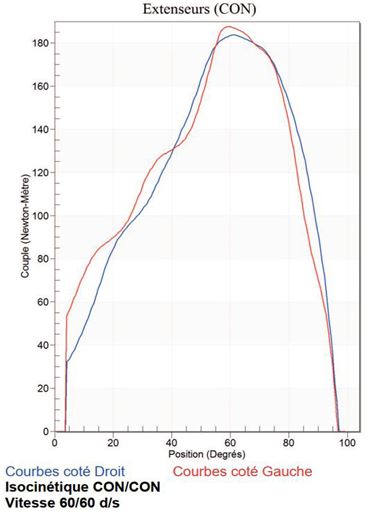Clinical Image - Volume 3 - Issue 5
Isokinetic torque curves abnormalities of the knee extensors during patellofemoral syndrome
El Youbi K*; Karkouri S
Department of Physical Medicine and Rehabilitation, University Hospital ibn Sina, Rabat, Morocco.
Received Date : July 18, 2023
Accepted Date : Aug 25, 2023
Published Date: Sep 01, 2023
Copyright: © El Youbi Khalid 2023
*Corresponding Author : El Youbi Khalid, Department of Physical Medicine and Rehabilitation, University Hospital ibn Sina, Rabat, Morocco.
Email: dr.khalid.elyoubi@gmail.com
DOI: Doi.org/10.55920/2771-019X/1538
Clinical Image
Patellofemoral pain syndrome (PFPS) is one of the most prevalent causes of anterior knee pain encountered by physicians. Its etiology remains without a clear consensus; however, it is probably multifactorial. One of the main factors seems to be muscular imbalance. Isokinetic assessment is regularly used in this regard to accurately measure muscle function at different modes and speeds and is therefore the investigation of choice in mechanical knee disorders such as PFPS. In the current work, we present figures illustrating a quantitative abnormality in knee extensor (quadriceps) curvatures during the concentric isokinetic test in patients with this disorder. This objectified anomaly occurs sporadically, although it is characteristic of pain during contraction curves. Aside from a deficiency of muscular strength, several factors have been related to these abnormal contraction curves, including the presence of potential musculotendinous retractions and the bone cause of the PFPS. On the other hand, these curve aspects, despite their occurrence during the PFPS, are neither sensitive nor specific.
Conflict of Interest: The authors have no conflict of interests to declare.
Figure 1: “Normal pattern” of isokinetic moment curves for knee extensor muscles (solid line).
Figure 2: “Valley” pattern of isokinetic moment curves.
Figure 3: “Drop” pattern of isokinetic moment curves.




